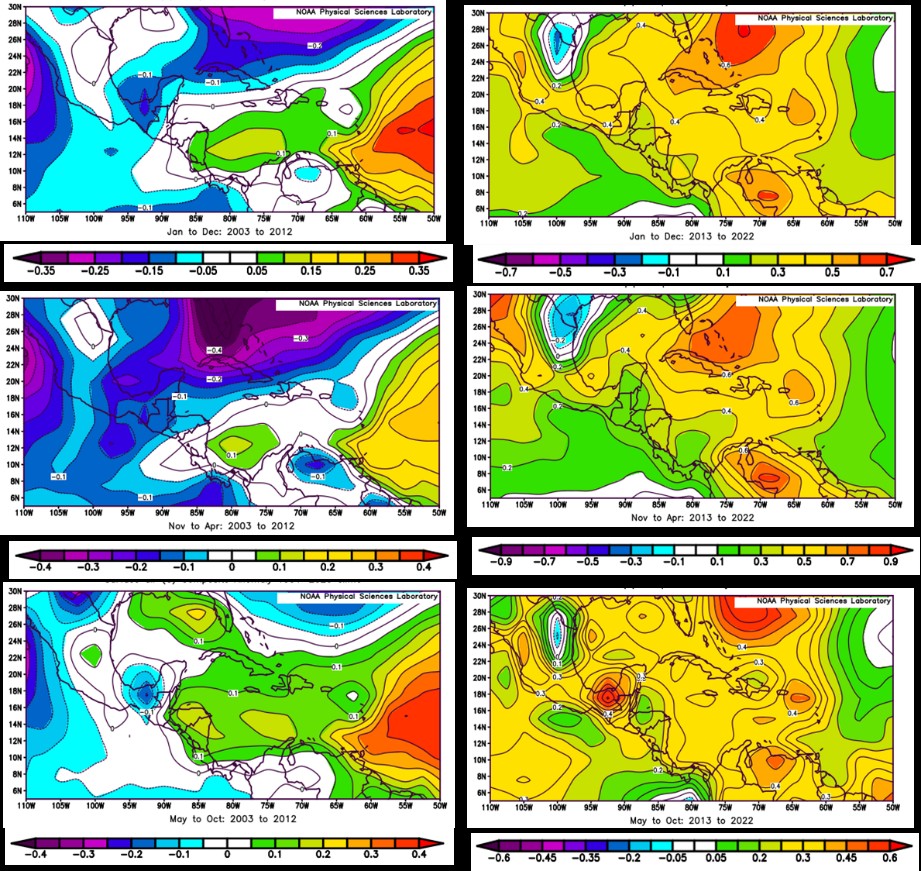Changes and trends observed in the air temperature over Cuba and its closest geographical surroundings
Main Article Content
Abstract
In the context of climate change, it is necessary to maintain systematic monitoring of the variations and changes that are occurring in the climate. In the particular case of temperature, the monitoring and analysis of its behavior, in the context of the significant tendencies of the same to a progressive increase of a global character, constitutes a task of high value, given the harmful processes that consequently take place. Its examination must be considered in the context of the more general background characteristics, which by their nature are related to it through existing processes in the different spatial and temporal scales that affect the climate and that lead to the variations and tendencies that have been occurring in the area and especially to its impact on the country. The temperature analysis presented below includes, in addition to the data on average surface temperatures in the country, those from nearby land and ocean areas in the Greater Caribbean, as well as those obtained from the vertical tropospheric structure over the area. The main results indicate that the average surface air temperature in Cuba and its surroundings continues to increase, with the last 5-year period showing the greatest increase, which is why our climate is becoming warmer.
Downloads
Article Details

This work is licensed under a Creative Commons Attribution-NonCommercial 4.0 International License.
Those authors who have publications with this journal accept the following terms of the License Attribution-NonCommercial 4.0 International (CC BY-NC 4.0):
You are free to:
- Share — copy and redistribute the material in any medium or format
- Adapt — remix, transform, and build upon the material
The licensor cannot revoke these freedoms as long as you follow the license terms.
Under the following terms:
- Attribution — You must give appropriate credit, provide a link to the license, and indicate if changes were made. You may do so in any reasonable manner, but not in any way that suggests the licensor endorses you or your use.
- NonCommercial — You may not use the material for commercial purposes.
- No additional restrictions — You may not apply legal terms or technological measures that legally restrict others from doing anything the license permits.
The journal is not responsible for the opinions and concepts expressed in the works, they are the sole responsibility of the authors. The Editor, with the assistance of the Editorial Committee, reserves the right to suggest or request advisable or necessary modifications. They are accepted to publish original scientific papers, research results of interest that have not been published or sent to another journal for the same purpose.
The mention of trademarks of equipment, instruments or specific materials is for identification purposes, and there is no promotional commitment in relation to them, neither by the authors nor by the publisher.
References
Centella A., L. Naranjo, L. Paz, P. Cárdenas, A. Alfonso, M. Ballester, B. Lapinel, C. González, R. Pérez, M. Limia y M. Sosa (1997). Variaciones y cambios del clima en Cuba. Informe del Centro Nacional del Clima. Instituto de Meteorología, La Habana, Cuba, 55 pp.
Dixon W.J. (1950). Analysis of extreme values. Annals of Math. Stat., 21, 488-506.
Dixon W.J. (1951). Ratios involving of extreme values. Annals of Math. Stat., 22, 68-78.
Dixon W.J. (1953). Processing data for outliers. J. Biometrics, 9, 74-89.
Fonseca, C. (1989). Análisis de la tendencia de la temperatura media del aire. Tesis de Diploma. Universidad de La Habana, La Habana, Cuba.
IPCC, (2021). Climate Change 2021. The Physical Science Basis. Contribution of Working Group I to the Sixth Assessment Report of the Intergovernmental Panel on Climate Change [Masson-Delmotte, V., P. Zhai, A. Pirani, S.L. Connors, C. Péan, S. Berger, N. Caud, Y. Chen, L. Goldfarb, M.I. Gomis, M. Huang, K. Leitzell, E. Lonnoy, J.B.R. Matthews, T.K. Maycock, T. Waterfield, O. Yelekçi, R. Yu, and B. Zhou (eds.)]. Cambridge University Press, Cambridge, United Kingdom and New York, NY, USA, 2391 pp. doi:10.1017/9781009157896.
IPCC, (2023). AR6 Synthesis Report, Climate Change 2023, https://www.ipcc.ch/report/ar6/syr/
Kawamura, R., Sugi, M., & Sato, N. (1995). Interdecadal and interanual variability in the Northern Extratropical Circulation simulated with the JMA Global Model. Part II: Summertime Leading Mode. Jour. of Climate.
Kendall, M.G. (1970). Rank Correlation Methods, fourth ed. Griffin, London
Mann, H. B. (1945). Non-parametric tests against trend. Econometrica 13, 245–259
Nicholls N., G. V. Gruza, J. Jouzel, T. R. Karl, L. A. Ogallo and D. E. Parker (1995). Observed climate variability and change. In Climate Change 1995. The Science of Climate Change. edit by J. T. Houghton, L. G. Meira Filho, B. A. Callander, N. Harris, A. Kattenberg and K. Maskell, Cambridge University Press, Cambridge.
Planos, E; Vega, R y A, Guevara, Editores, (2013). Impacto del Cambio Climático y Medidas de Adaptación en Cuba. Instituto de Meteorología, Agencia de Medio Ambiente, Ministerio de Ciencia, Medio Ambiente y Tecnología. La Habana, Cuba, 430 pp.
R Core Team (2017). R A Language and Environment for Statistical Computing.
https://www.R-project.org/
Sen, P.K. (1968). Estimates of the Regression Coefficient based on Kendall’s Tau. Journal of the American Statistical Association, 63, 1379-1389.
http://dx.doi.org/10.1080/01621459.1968.10480934
Şen, Z. (2014). Trend identification simulation and application. J Hydrol Eng 19(3):635–642
Şen, Z. (2017). Innovative trend significance test and applications. Theor Appl Climatol 127(3):939–947.

